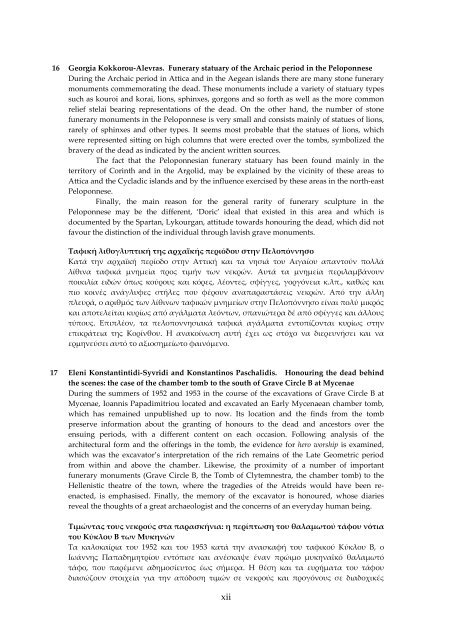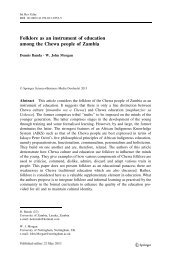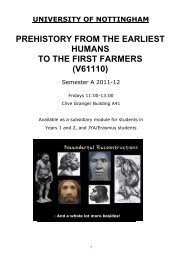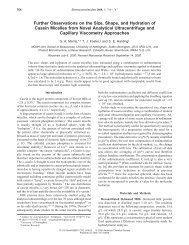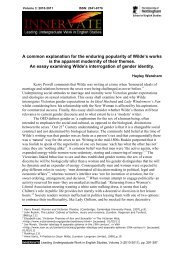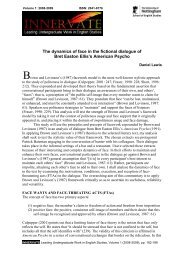Honouring the Dead in the Peloponnese - University of Nottingham
Honouring the Dead in the Peloponnese - University of Nottingham
Honouring the Dead in the Peloponnese - University of Nottingham
Create successful ePaper yourself
Turn your PDF publications into a flip-book with our unique Google optimized e-Paper software.
16 Georgia Kokkorou-Alevras. Funerary statuary <strong>of</strong> <strong>the</strong> Archaic period <strong>in</strong> <strong>the</strong> <strong>Peloponnese</strong><br />
Dur<strong>in</strong>g <strong>the</strong> Archaic period <strong>in</strong> Attica and <strong>in</strong> <strong>the</strong> Aegean islands <strong>the</strong>re are many stone funerary<br />
monuments commemorat<strong>in</strong>g <strong>the</strong> dead. These monuments <strong>in</strong>clude a variety <strong>of</strong> statuary types<br />
such as kouroi and korai, lions, sph<strong>in</strong>xes, gorgons and so forth as well as <strong>the</strong> more common<br />
relief stelai bear<strong>in</strong>g representations <strong>of</strong> <strong>the</strong> dead. On <strong>the</strong> o<strong>the</strong>r hand, <strong>the</strong> number <strong>of</strong> stone<br />
funerary monuments <strong>in</strong> <strong>the</strong> <strong>Peloponnese</strong> is very small and consists ma<strong>in</strong>ly <strong>of</strong> statues <strong>of</strong> lions,<br />
rarely <strong>of</strong> sph<strong>in</strong>xes and o<strong>the</strong>r types. It seems most probable that <strong>the</strong> statues <strong>of</strong> lions, which<br />
were represented sitt<strong>in</strong>g on high columns that were erected over <strong>the</strong> tombs, symbolized <strong>the</strong><br />
bravery <strong>of</strong> <strong>the</strong> dead as <strong>in</strong>dicated by <strong>the</strong> ancient written sources.<br />
The fact that <strong>the</strong> Peloponnesian funerary statuary has been found ma<strong>in</strong>ly <strong>in</strong> <strong>the</strong><br />
territory <strong>of</strong> Cor<strong>in</strong>th and <strong>in</strong> <strong>the</strong> Argolid, may be expla<strong>in</strong>ed by <strong>the</strong> vic<strong>in</strong>ity <strong>of</strong> <strong>the</strong>se areas to<br />
Attica and <strong>the</strong> Cycladic islands and by <strong>the</strong> <strong>in</strong>fluence exercised by <strong>the</strong>se areas <strong>in</strong> <strong>the</strong> north-east<br />
<strong>Peloponnese</strong>.<br />
F<strong>in</strong>ally, <strong>the</strong> ma<strong>in</strong> reason for <strong>the</strong> general rarity <strong>of</strong> funerary sculpture <strong>in</strong> <strong>the</strong><br />
<strong>Peloponnese</strong> may be <strong>the</strong> different, ‘Doric’ ideal that existed <strong>in</strong> this area and which is<br />
documented by <strong>the</strong> Spartan, Lykourgan, attitude towards honour<strong>in</strong>g <strong>the</strong> dead, which did not<br />
favour <strong>the</strong> dist<strong>in</strong>ction <strong>of</strong> <strong>the</strong> <strong>in</strong>dividual through lavish grave monuments.<br />
Ταφική λιθογλυπτική της αρχαϊκής περιόδου στην Πελοπόννησο<br />
Κατά την αρχαϊκή περίοδο στην Αττική και τα νησιά του Αιγαίου απαντούν πολλά<br />
λίθινα ταφικά μνημεία προς τιμήν των νεκρών. Αυτά τα μνημεία περιλαμβάνουν<br />
ποικιλία ειδών όπως κούρους και κόρες, λέοντες, σφίγγες, γοργόνεια κ.λπ., καθώς και<br />
πιο κοινές ανάγλυφες στήλες που φέρουν αναπαραστάσεις νεκρών. Από την άλλη<br />
πλευρά, ο αριθμός των λίθινων ταφικών μνημείων στην Πελοπόννησο είναι πολύ μικρός<br />
και αποτελείται κυρίως από αγάλματα λεόντων, σπανιώτερα δέ από σφίγγες και άλλους<br />
τύπους. Επιπλέον, τα πελοποννησιακά ταφικά αγάλματα εντοπίζονται κυρίως στην<br />
επικράτεια της Κορίνθου. Η ανακοίνωση αυτή έχει ως στόχο να διερευνήσει και να<br />
ερμηνεύσει αυτό το αξιοσημείωτο φαινόμενο.<br />
17 Eleni Konstant<strong>in</strong>tidi-Syvridi and Konstant<strong>in</strong>os Paschalidis. <strong>Honour<strong>in</strong>g</strong> <strong>the</strong> dead beh<strong>in</strong>d<br />
<strong>the</strong> scenes: <strong>the</strong> case <strong>of</strong> <strong>the</strong> chamber tomb to <strong>the</strong> south <strong>of</strong> Grave Circle B at Mycenae<br />
Dur<strong>in</strong>g <strong>the</strong> summers <strong>of</strong> 1952 and 1953 <strong>in</strong> <strong>the</strong> course <strong>of</strong> <strong>the</strong> excavations <strong>of</strong> Grave Circle B at<br />
Mycenae, Ioannis Papadimitriou located and excavated an Early Mycenaean chamber tomb,<br />
which has rema<strong>in</strong>ed unpublished up to now. Its location and <strong>the</strong> f<strong>in</strong>ds from <strong>the</strong> tomb<br />
preserve <strong>in</strong>formation about <strong>the</strong> grant<strong>in</strong>g <strong>of</strong> honours to <strong>the</strong> dead and ancestors over <strong>the</strong><br />
ensu<strong>in</strong>g periods, with a different content on each occasion. Follow<strong>in</strong>g analysis <strong>of</strong> <strong>the</strong><br />
architectural form and <strong>the</strong> <strong>of</strong>fer<strong>in</strong>gs <strong>in</strong> <strong>the</strong> tomb, <strong>the</strong> evidence for hero worship is exam<strong>in</strong>ed,<br />
which was <strong>the</strong> excavator’s <strong>in</strong>terpretation <strong>of</strong> <strong>the</strong> rich rema<strong>in</strong>s <strong>of</strong> <strong>the</strong> Late Geometric period<br />
from with<strong>in</strong> and above <strong>the</strong> chamber. Likewise, <strong>the</strong> proximity <strong>of</strong> a number <strong>of</strong> important<br />
funerary monuments (Grave Circle B, <strong>the</strong> Tomb <strong>of</strong> Clytemnestra, <strong>the</strong> chamber tomb) to <strong>the</strong><br />
Hellenistic <strong>the</strong>atre <strong>of</strong> <strong>the</strong> town, where <strong>the</strong> tragedies <strong>of</strong> <strong>the</strong> Atreids would have been reenacted,<br />
is emphasised. F<strong>in</strong>ally, <strong>the</strong> memory <strong>of</strong> <strong>the</strong> excavator is honoured, whose diaries<br />
reveal <strong>the</strong> thoughts <strong>of</strong> a great archaeologist and <strong>the</strong> concerns <strong>of</strong> an everyday human be<strong>in</strong>g.<br />
Τιμώντας τους νεκρούς στα παρασκήνια: η περίπτωση του θαλαμωτού τάφου νότια<br />
του Κύκλου Β των Μυκηνών<br />
Τα καλοκαίρια του 1952 και του 1953 κατά την ανασκαφή του ταφικού Κύκλου Β, ο<br />
Ιωάννης Παπαδημητρίου εντόπισε και ανέσκαψε έναν πρώιμο μυκηναϊκό θαλαμωτό<br />
τάφο, που παρέμενε αδημοσίευτος έως σήμερα. Η θέση και τα ευρήματα του τάφου<br />
διασώζουν στοιχεία για την απόδοση τιμών σε νεκρούς και προγόνους σε διαδοχικές<br />
xii


